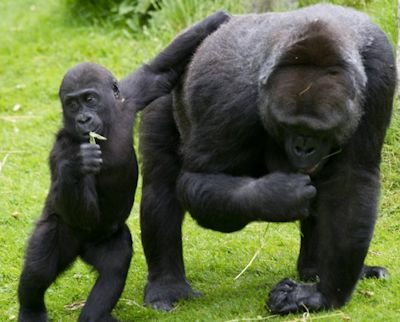Did_You_know …. About Gorillas
 orillas are a rare species, their physical appearance and behavior have marveled many and for that reason millions and millions of people have traveled from all parts of the world for a Safari in Uganda to enjoy a Gorilla Tracking Safari during which they will have an opportunity to see them. In this article we have pointed out some interesting facts that you may not know about gorillas
orillas are a rare species, their physical appearance and behavior have marveled many and for that reason millions and millions of people have traveled from all parts of the world for a Safari in Uganda to enjoy a Gorilla Tracking Safari during which they will have an opportunity to see them. In this article we have pointed out some interesting facts that you may not know about gorillas
Gorillas are man’s wild cousins
Mountain Gorillas share over 90% of the DNA with man. Similar to man, gorillas posses 2 legs with 10 toes and 2 arms each with 5 fingers. They have small ears one on every side of their head, 32 teeth as well as eyes looking forward.
On the contrary they have arms that are more muscular and longer than their legs, whereas their large toes resemble like thumbs. With exception on the face, soles of the feet, palms, chest and underarms a gorilla’s body is entirely covered with thick-dark hair. The adult males at full maturity (around 15 years) the hair on their backs turns grey and for that reason they are called the Silverback
There are Four Gorilla Subspecies
There are 4 gorilla subspecies which include: the Cross River gorilla (Gorilla gorilla diehl), mountain gorilla (Gorilla beringei beringei), western lowland gorilla (Gorilla gorilla gorilla) as well as the eastern lowland or Grauer’s gorilla (Gorilla beringei graueri).
They Walk on Four limbs
Similar to great apes, the gorillas have legs shorter than their arms and they walk on all their four limbs sometimes – a movement known as ‘knuckle walking’.
They are Herbivores
Gorillas are strictly herbivores and they feed on leaves, fruits, shoots, vines and, roots.
Gorilla Population
There are less than 800 Mountain gorillas in the world and these have been labeled as a critically endangered species, less than 5,000 Eastern lowland gorillas, then the Cross River gorillas are another critically endangered species with less than 300survivng. However the western lowland gorillas are over 150, 000 in number.
The live in the Green forest ofAfrica
The Eastern lowland gorillas live in the eastern part of the Democratic Republic of Congo, Uganda as well as Rwanda. Mountain gorillas live in the Virunga mountain area spanning the borders of DR Congo, Rwanda and Uganda, and also can be seen in Uganda’s Bwindi Impenetrable National Park.
The Western lowland gorillas live in the forests of Equatorial Guinea, Gabon, Cameroon, eastern DRC, Nigeria as well as the Central African Republic.
The Cross River gorillas are limited to a tinny area in Cameroon as well as Nigeria.
Who makes the Decisions
Gorillas spend most of their time on the ground and they live in families/groups of 6 to 12 members with a dominant male (Silverback) leading the group comprised of adult females, the young male and female and then their babies. Decisions regarding when to wake up, feed, move or even rest is made by the Silverback.
They Charge when Angry
Gorillas especially the Silverback have tendency of protecting their family. so each time they get threatened they become very aggressive and In such instances the Silverback which protects the family will charge and beat its chest.
They are Shy
Although they are huge giants, Gorillas are generally very shy and mainly active in the day. At sunset they make their nests and the nursing young ones share their nests with their mothers.
The grown males leave their Families
At around 13 years, the grown males leave their gorilla group / family to start a new family or live a Solitary life. Remember the silverback has the right to mate with any male within his group.
They Can Also Produce Twins
Although this is very rare thing, it has come to book that some gorillas even just recently (2013 in Rwanda) can produce twin. Mating can happen all year round and they have a gestation period of 8 and half months.
Baby Gorillas Crawl at 2 months
At birth a gorilla weighs approximately 3-4 lbs. At around 2 months they begin to crawl and at 8-9 months they are already walking
Man is the number one Threat to Gorillas
Habitat loss is a big threat to the survival of the gorilla population, and this has been mainly caused by the increasing human population which in the long run has encroached on the gorilla habitat for settlement and farming. Also in some areas, people have been poaching gorillas for bushmeat.
